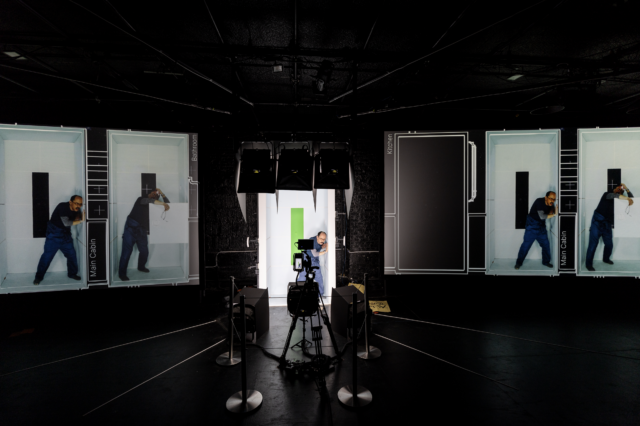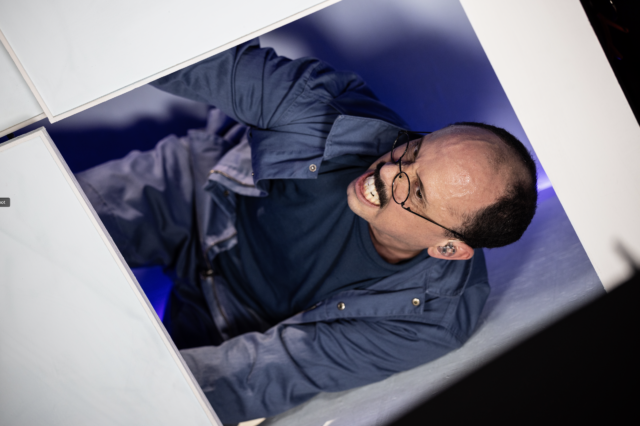
The 7th Voyage of Egon Tichy [Redux] is a dazzling multimedia theatrical experience (photo by Maria Baranova)
THE 7th VOYAGE OF EGON TICHY [REDUX]
New York Theatre Workshop Fourth Street Theatre
83 East Fourth St. between Second & Third Aves.
Through February 2, $30-$50 (Sunday livestreams $19)
utrfest.org
www.nytw.org
During the pandemic, Joshua William Gelb transformed his eight-square-foot closet in the East Village into a pristine white digital stage, where he presented awe-inspiring productions he christened Theater in Quarantine, using cutting-edge digital technology for such livestreamed shows as Heather Christian’s I Am Sending You the Sacred Face: One Brief Musical Act with Mother Teresa, Footnote for the End of Time based on a story by Jorge Luis Borges, and Nosferatu: A 3D Symphony of Horror in addition to smaller works that displayed the wide range of performance he and his collaborators could do with the space.
It was an ingenious concept that captured the feelings so many of us experienced when theaters were closed and many of us started working remotely from home, cut off from seeing friends and relatives for long periods of time. One of the shows, The 7th Voyage of Egon Tichy, adapted from sci-fi author Stanislaw Lem’s The Star Diaries, explored that loneliness in the extreme, introducing the audience to an astronaut on a solo mission who needs to repair his ship’s rudder, a two-person job. Along the way he encounters vortices that result in multiple versions of himself who have to team up if the spacecraft is to be fixed.
Created by director Jonathan Levin, playwright Josh Luxenberg, and actor Gelb, the thirty-six-minute online Tichy has now been reimagined as The 7th Voyage of Egon Tichy [Redux], a staggeringly inventive hourlong multimedia play running through February 2 at New York Theatre Workshop’s intimate Fourth Street Theatre, as part of the Under the Radar festival.

Joshua William Gelb plays multiple versions of an astronaut in technological marvel (photo by Maria Baranova)
Peiyi Wong’s set consists of two large screens on either side of a replica of Gelb’s closet, with various small doors that open and close inside. A smartphone on a tripod focuses on the closet, which has a slit in the back that allows outer space to be visible via a green screen. Marika Kent’s lighting setup and M. Florian Staab’s sound and original music immerses the audience in the action. All of the technical elements may be visible, but that doesn’t mean you’ll have any idea how they pull off their dazzling magic, mastered by video designer Jesse Garrison.
Tichy’s ship has been damaged by a meteor the size of a lima bean, putting him parsecs off course, and he is unable to repair it by himself. Thinking he is having a dream, he encounters a second version of himself, but he has traveled through a time vortex and it is actually him one day in the future. “I need your help,” Tuesday Tichy tells Monday Tichy, who says, “You look so realistic.” Tuesday explains, “I am! This is all real.” Monday: “This room looks just like my room.” Tuesday: “It is! I was you yesterday. And I didn’t listen. But if you do exactly what I —”
The scene is startling for several reasons. First, the real Gelb is in the closet, standing against the wall, his head on a pillow, but on the screens, he is lying down on the floor, as the video has turned the closet horizontal. Second, the real Gelb is interacting with a prerecorded Gelb; while there are two Gelbs in the video closet, only one is live, and it quickly becomes clear that it requires precision timing to make it work, including the use of such props as a wrench, pliers, the spacesuit, a frying pan, and a bloody towel. And third, it echoes the solitary nature of the pandemic, when we often lost track of time and ached to be with others, an emotion that is furthered when the vortex adds more future Tichys and the plot moves from the sleeping quarters and the kitchen to the vestibule, bathroom, and main cabin.
Lem, who also wrote such novels as Solaris, The Invincible, and Fiasco, constructed a fantastical universe for Tichy that spans numerous tales. Gelb is hilarious as multiple Tichys, using the doors to magically disappear, go up and down between floors, and angle his body so it might be awkward in the vertical closet but makes sense in the horizontal video. He never misses a beat as more and more Egons (spelled Igons by Lem) join him in the cramped space. It’s a tour de force for everyone involved, both as it relates to the pandemic and the world finally getting on with life outside and lending insight into how each of us tries to understand and substantiate our identities and our place with others in a forever-changed environment that we cannot survive on our own.
In an introduction to one of the Tichy books, Professor A. S. Tarantoga of the Associated Institutes of Tichology, Tichography, and Tichonomics Descriptive, Comparative, and Prognostic posits, “In conclusion I should like to announce the establishment in our Association of a special futurological section, which, in keeping with the spirit of the times, will make available — using the method of so-called self-realizing prognoses — those star journeys of I. Tichy which as yet he has not undertaken, nor indeed intends to.”
It’s an uncanny way to meld past, present, and future, which forms the core of who we are as humans, in print, online, and in person.
[Mark Rifkin is a Brooklyn-born, Manhattan-based writer and editor; you can follow him on Substack here.]